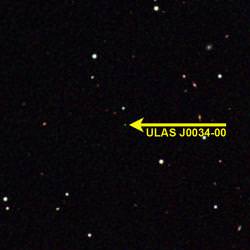Brown dwarfs are failed stars that didn’t have the mass to ignite fusion. But where do you draw the line between a large planet and a failed star? The Gemini observatory has helped discover the coolest brown dwarf ever seen. It’s right in the middle between a star and planet.
The object is called ULAS J0034-00, and it weighs in around 15-30 times the mass of Jupiter. That sounds like a lot, but it’s actually so small that it has the coolest surface temperature ever seen for a brown dwarf: 600-700 degrees Kelvin. It’s only 50 light-years away, much closer than most of the stars you can see with the unaided eye. But it’s so cool, only a powerful observatory can actually see it.
The finding was announced today at the American Astronomical Society meeting in Honolulu, Hawaii by an international team of astronomers. Their discovery was first made using the United Kingdom Infrared Telescope (UKIRT), and then follow up observations with Gemini Observatory’s Near Infrared Spectrograph (GNIRS) on Gemini South.
This discovery opens up the possibility that even lower-mass objects are out there, further blurring the line between high-mass planets and the smallest brown dwarfs.
Original Source: Gemini News Release

